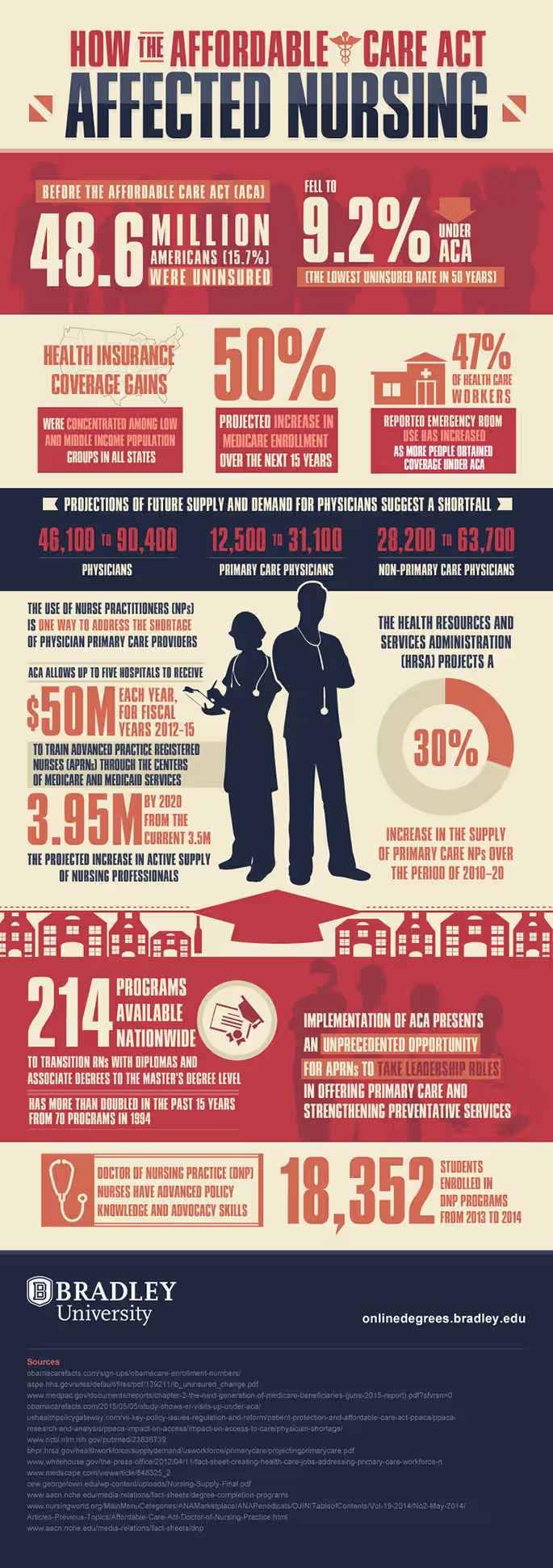How The Affordable Care Act Affected Nursing

Add This Infographic to Your Site
<p style="clear:both;margin-bottom:20px;"><a href="https://onlinedegrees.bradley.edu/blog/how-the-affordable-care-act-affected-nursing" rel="noreferrer" target="_blank"><img src="https://res.cloudinary.com/dqtmwki9i/image/fetch/https://www.project-alpine.com/assets/0f289f6a-2bd7-4de7-bc85-e094f724b3b1" alt="Infographics on How the Affordable Care Act Affected Nursing and Significantly Lowered the Rate of Uninsured Americans" style="max-width:100%;" /></a></p>
Who Is Benefiting from the Affordable Care Act (ACA)
The changes in uninsured rates have been concentrated to predominately lower- and middle-class income populations. With many Americans falling just slightly over the requirements for low-income health care assistance and other government-funded programs, this news is excellent for those individuals who may have, up until now, not been able to afford coverage. Surprisingly, just a handful of dollars can make or break a family’s ability to qualify for programs such as Medicaid that assists expectant mothers and children with getting the health care and medications that they need. The ACA has, in many ways, bridged the gap between care and no care for these groups. There is also a 50 percent projected increase in Medicare enrollees over the next 15 years, bringing more of those people who may have fallen through the cracks into the safety net of health care coverage.
Noticeable Changes Here and Now
Projected changes are not the only change happening in health care thanks to the ACA. Forty-seven percent of emergency room personnel have reported noticeable increases in emergency room use since the ACA’s inception. This boom in patient activity has left many hospitals short staffed, forcing longer wait times for patients in need of care — a potentially dangerous problem, especially in emergency departments where time is of the essence.
More Supply and Demand Challenges Ahead
Projections indicate that this issue of increased demand will only worsen as the population increases and the remaining 9.2 percent of uninsured Americans obtain coverage. In the foreseeable future, the supply and demand of physicians to patients will be around 46,100 to 90,400. The gap between primary care doctors and their patients will rise as well, leaving 12,500 primary care providers to tend to 31,100 patients. Lastly, non-primary care physicians also will be short staffed at 28,200 to 63,700. As medical teams rally to face the challenges ahead, great care is being taken to make sure the challenges are met in a timely and effective manner, ensuring that no patients have to go without the vital care they need.
Solutions for Increasing Demand
One way to address physician shortages is through the increase of nurse practitioners (NPs). Many practices already employ at least one NP, if not more, at their facilities. Adding more NPs can allow medical teams to treat more patients at once and do so in a timely fashion. This option prevents a decrease in quality of care that can stem from rushed visits and long hours as a result of overbooking.
Grants and Funding for Understaffed Hospitals
The ACA allows up to five hospitals to be the recipients of $50 million per year for the fiscal years of 2012–15. This money makes the training of advanced practice registered nurses (APRNs) through the centers of Medicaid and Medicare services possible. By the year 2020, the ACA should achieve the long-term goal of increasing the supply of nursing professionals from the current 3.95 million active today. These figures come from the Health Resources and Services Administration, which projects a 30 percent increase in the active supply of NPs from 2010–20.
Equipping Qualified Hopefuls with the Ability to Help Make Change
The solutions to rise up and meet the challenges brought on by supply and demand are there. The time to begin working toward these vital changes is now. With 214 programs available across the nation, RNs can easily transition from associate degrees and diplomas to the master’s degree level. The number of programs available nationwide has doubled since 1994, which boasted only 70 available programs at the time.
While the introduction of the ACA has invented new supply and demand problems, it also has created a bevy of opportunities for nurses to grow toward larger, better-paying positions. In return, the willingness of nurses to gain further education, which can take away from personal time, gifts the offices, hospitals and urgent care facilities that employ them with the ability to strengthen preventative care and increase patient satisfaction. Without these men and women, an already noticeable problem could grow into an epidemic of lackluster care, which could make many of the ACA’s benefits obsolete.
Looking Forward to a Healthier Tomorrow
The ACA has helped millions of Americans gain the coverage that they deserve to get the care they need. However, if appointment space is limited and physicians are short staffed, patients could be at risk for letting medical problems go on without timely attention. Nurse practitioners offer these patients the ability to be seen sooner rather than later, helping them to get the medications and advice that they are in need of without settling for low-quality, hurried care.
Doctor of Nursing Practice (DNP) nurses are equipped with advanced policy knowledge and advocacy skills. Thus, they grow their list of regular patients quite quickly. From 2013–14, 18,352 students were enrolled in DNP programs. Together, those dedicated men and women were among the first to rise up to meet the important challenges the ACA has presented, blazing a trail for more to follow, each working to create an America that is not only healthier but, as a result, much happier.